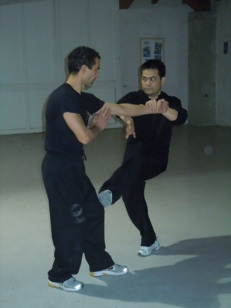Vinh Xuan






IVinh Xuan is the vietnames school of Wing chun. This name surely comes from the maiden Yim Wing Chun (“eternal spring”). After a long time of practice with her master, the monk Ngu Mui (which si thought to be the founder of this style), Yim Wing Chun became one the most representative figures of this school and left a trace so deep in the style that she could create a new school which brought her name.
Legends tell that in the XVII century the Shaolin Temple was thought to be the lair of rebels and opponents of the Manchurian Empire: it was then sieged and destroyed. Only a few monks, loyal to the Ming family, survived the attackand between them was also Ngu Mui. She had to grow in a few time an army of fighters who could successfully oppose the Shaolin techniques of the enemy: she decided to create a new training method. One day, as she was observing a fight between a crane and a snake, Ngu Mui had the insight to create a new fighting technique at a short distance. She tried to emulate the swiftness and softness of the snake with her body and the crane’s peck and wing movements with arms and legs. This way she created a new style which opposed radically to the teachings of Shaolin, exalting short over long distance and softness in movements over stillness of the body. These principles were transmitted on to her first student Yim Wing Chun, which was capable to create a new style, practiced nowadays under the name of Wing Chun or Vinh Xuan.
The Vietnamese branch of Wing Chun was originated by the Chinese master Luong Vu Te (Yuen Chai-Wan). Master Luong Vu Te was a military counselor of the Chinese nationalist army during World War II. Haunted by the Japanese intelligence, in 1940 he had to escape to northern Vietnam with the name of Nguyen Te Cong to hide his true identity. He grounded an important martial arts school in Hanoi, where he taught almost only to students of Chinese origins: his only Vietnamese student was master Ngo Si Qui (dead 1997), whose disciple was master Tran Ngoc Dinh (direct teacher of master Cam Thanh Lam). After 1954, with the division between northern and southern Vietnam, the founder master of Vihn Xuan moved to Saigon (Ho Chi Minh City) where he kept teaching until his death in 1963, at the age of 93.
The study of Vinh Xuan needs a long work consisting in “freeing” several articulations of the body (wrist/ankle= first ring; elbow/knee= second ring; shoulder/hips= third ring) and exercises focused on balancing weights with each other. This kind of work gives arms and legs a great sensitivity and develops the capacity react in a sudden and instinctive way to external cues; moreover, the student comes to understand the points of balance in movements and weight dynamics, essential concepts in close-up combat. Disciples will then study Quyens, which allow to apprehend more complex attack and defense techniques. But the true key of Vinh Xuan is the two-person training system called Tam Kieu (“Chi Sau” in Chinese which means “sticky hands”) with whom the student can develop the sensitivity to perceive direction, intensity and other characteristics of might applied by opponents in their moves. The philosophy of Vinh Xuan can be resumed in these principles “feel, deviate, follow and counter-attack”.





